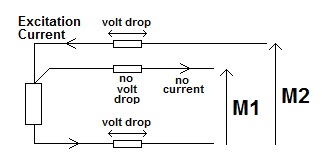You shouldn't hook up multiple RTDs to a single current source in parallel. You would end up with more unknowns than equations. You measure the voltage across some particular RTD, but you don't know the excitation current into that particular RTD, and of course you don't know the resistance.
\$ \left\{
\begin{array}{l l}
V_{RTD,1}=I_{exc,1}R_{RTD,1}\\
V_{RTD,2}=I_{exc,2}R_{RTD,2}\\
I_{exc} = I_{exc,2} + I_{exc,2}
\end{array} \right.
\$
I have left out the parasitic lead resistance.
\$I_{exc,1}\$, \$I_{exc,2}\$, \$R_{RTD,1}\$, \$R_{RTD,2}\$ are 4 unknowns. We have only 3 equations. So, this parallel connection doesn't work even for the case of 2x RTDs.
Either multiplex the current source and energize one RTD at a time. Or, provide an individual current source for each RTD.
If you hook up all of the RTDs in series, how are you going to measure and compensate for the lead in a 3-wire scheme? It should be possible, but I'm not sure that that would be simpler.
I would also be careful with your 2-channel A/D approach where a separate A/D conversion is made to cancel out the lead resistance in a 3-lead configuration. With an analog approach, you compensate for the lead instantly in analog . With 2-challel, you make a measurement of the RTD at a time τ1, and then you make another measurement of the lead at a time τ2. There will be 50 or 60 Hz noise from the mains. Due to noise, the state at τ2 may be different from τ1, and your compensation may introduce some error. You can alleviate this by filtering and/or canceling out the 50 or 60 Hz noise.
Analog Devices note CN-0287 describes a front end for measuring multiple RTDs. It uses a single current source. See p.4

